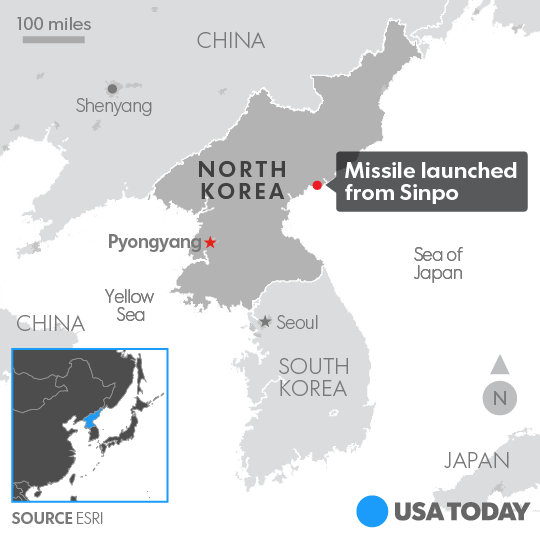North Korea's missile launch: What we know
North Korea attempted to launch a new missile Sunday, but the device "blew up almost immediately," the U.S. military said.
Here's what we know:
Where did the test occur?
The U.S. and South Korea's military said Sunday's missile was launched from Sinpo, on North Korea's east coast, about 182 miles from Seoul, South Korea.
The Pentagon and South Korea's Joint Chiefs of Staff said it wasn’t immediately clear what type of missile was involved. An unnamed White House official told the Associated Press the failure involved a medium-range ballistic missile.

Why did the test occur?
The test came one day after Saturday's military parade the capital of Pyongyang, which marked the 105th anniversary of the birth of regime founder Kim Il-Sung. Tens of thousands of North Korean soldiers goose-stepped and new missiles and other military hardware were wheeled out in a show of military strength.
The timing also coincides with increasing tensions between the U.S. and North Korea. "Our toughest counteraction against the U.S. and its vassal forces will be taken in such a merciless manner as not to allow the aggressors to survive," a spokesperson for North Korea’s military said ahead of the parade, according to the state-run KCNA news agency.
Read more:
15 fascinating facts about mysterious North Korea
For North Korea, sanctions are safer than a strike, experts say
Americans strongly back military use to defend allies from North Korea
What was the U.S. reaction?
Reaction by U.S. officials was mostly muted after the attack. On Twitter, President Trump suggested that China is helping with the North Korea problem as part of a deal with the U.S. involving trade policy.
"Why would I call China a currency manipulator when they are working with us on the North Korean problem?" Trump tweeted. "We will see what happens!"
Trump's national security adviser, Lt. Gen. H.R. McMaster, said: "There’s an international consensus now, including — including the Chinese and the Chinese leadership — that this is a situation that just can’t continue."
Meanwhile, the USS Carl Vinson aircraft carrier group is approaching the Korean Peninsula.
Secretary of Defense Jim Mattis issued a brief statement after news of the launch became public saying that President Trump and “his military team are aware of North Korea's most recent unsuccessful missile launch," but that "the president has no further comment."
What happens next?
In addition to the Vinson, Vice President Mike Pence arrived in South Korea Sunday afternoon as a sign of U.S. commitment to its South Korean ally.
North Korea, for its part, does not seem to be taking Trump's comments and tweets lightly. North Korea’s vice foreign minister Han Song Ryol told The Associated Press on Friday that "Trump is always making provocations with his aggressive words.”
Ryol threatened in the interview that North Korea was ready to go war against the U.S. He also said the communist state would continue to develop its nuclear weapons program and conduct tests as its leadership saw fit. North Korea has conducted five nuclear tests since 2006.
"We've got a powerful nuclear deterrent already in our hands, and we certainly will not keep our arms crossed in the face of a U.S. pre-emptive strike," he said.
Trump has warned the North that the U.S. will not allow it to develop a long-range missile capable of carrying a nuclear warhead that could reach the continental United States. Analysts believe the regime is making progress toward that goal.
China, the only country with leverage over its neighbor to the south, has warned both the U.S. and North Korea to lower their aggressive rhetoric. China is North Korea's main trading partner and Chinese companies produce military components for the North.
Read more:
A timeline of North Korea-U.S. flashpoints
North Korea executions under Kim Jong Un
Hey, Trump, here's why China won't 'go into' North Korea
